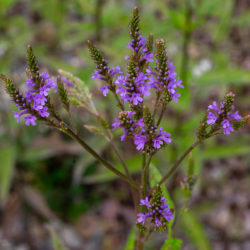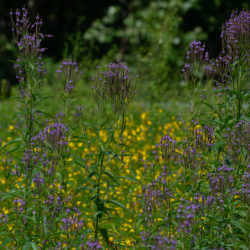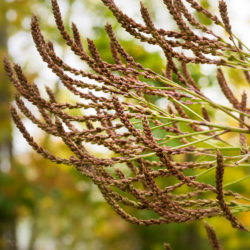Etymology
From Latin: Verbena = sacred plant, and hastata = spear-shaped.
Native Habitat
Meadows, roasides, marshes, stream bans, shorelines
Garden Uses
Prefers full sun and average to moist soil
Overview
An attractive clumping perennial that blooms from mid-summer through early fall and attracts a large number of pollinators. Verbena prefers full sun and average to moist soil. In optimal growing conditions, it may form colonies by slowly spreading rhizomes and self-seeding. Verbena hastata can be effectively used in borders as well as informal naturalized areas. Can be short lived. In ancient times the plant was thought to be a cure-all and drunk as a tea to ward off vampires.
Leaves and Stems
The plants have multiple 2’ – 5’ tall, stiffly erect, rough square stems and spread about 1’-2’. The stems are green or reddish with white hairs. The leaves are opposite, simple, 6” long and 1” wide. They have sharply serrated edges, prominent veins and pointed tips.
Flowers
Many pencil-like flower spikes branched like the arms of a candelabra. Each flower spike has a ring of blue-purple tubular flowers at the bottom of the spike. The flowers bloom along the spike from the bottom upwards for about 6 weeks.
Fruit/Seed
Plants are prolific seed producers that readily reseed in the garden.
Wildlife Associates
Bees are important pollinators. It attracts butterflies, moths and beneficial wasps. It is a larval host to Junonia coenia (common buckeye butterfly). Birds forage for the seed in the winter.
Propagation
Easy to propagate by seed which ripens over the season. Stem cuttings are also feasible.
Garden Location
Library Garden, West Woods (see garden map)
Sources
Ladybird Johnson Wildflower Project
William Cullina. Wildflowers: A guide to growing and propagating native flowers of North America. The New England Wild Flower Society 2000.
Plant Profile by Kathy Kling




